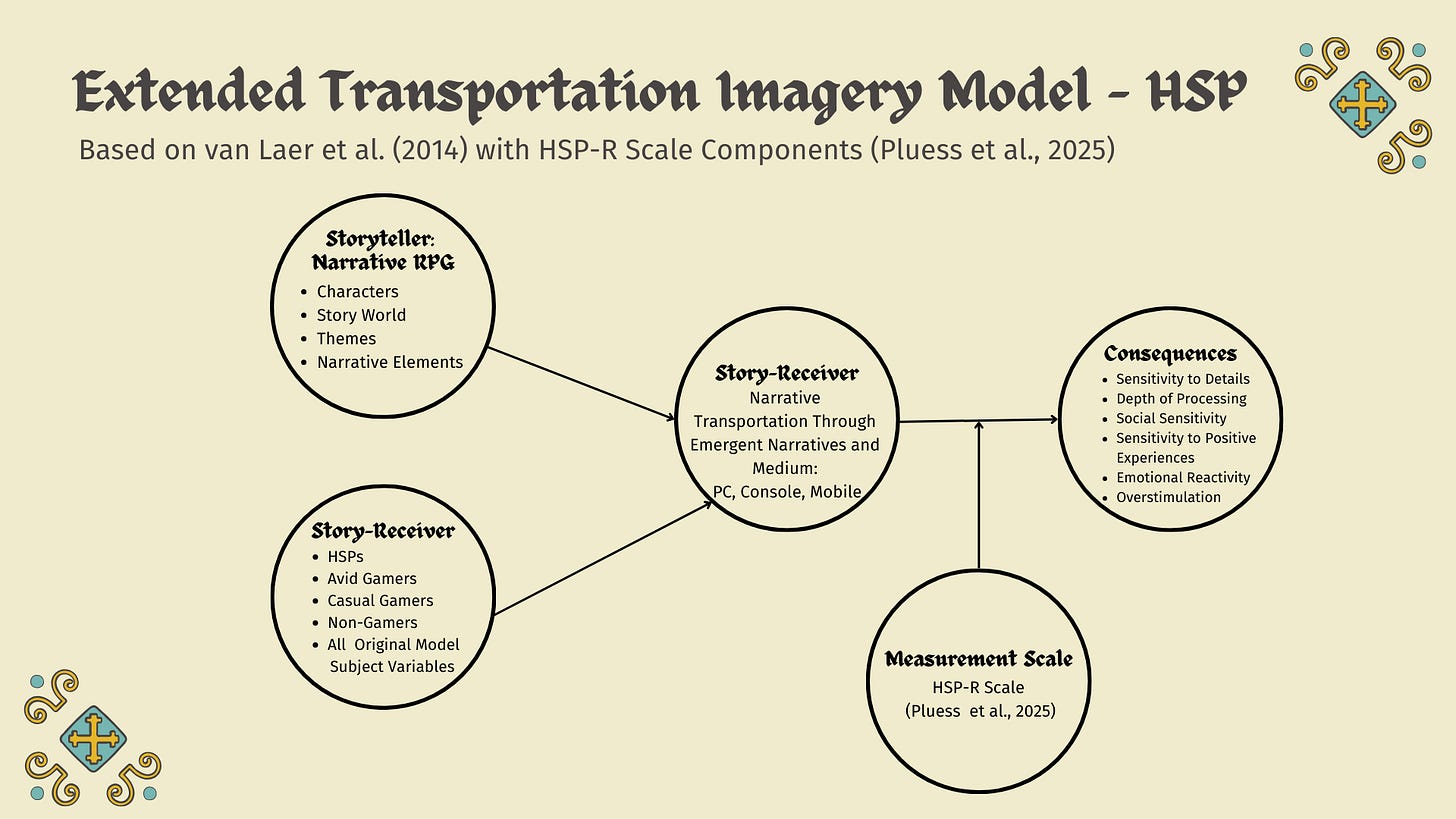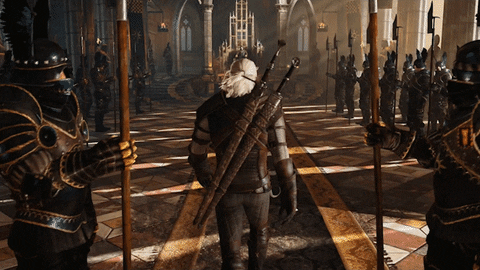Press Start To Go Home
“The Witcher 3: Wild Hunt” and Video Games as Virtual Homelands
I don’t know if I will get into this game. It looks so drab, I scoff as I overlook White Orchard in “The Witcher 3: Wild Hunt.” It’s my first foray into the beloved RPG from CD Projekt Red, and at first, I am not impressed. (It’s reminiscent of that botched “Cyberpunk 2077” launch.) As Geralt directs Roach on a dirt road amongst straw-thatched roofs and dirty river water, I long for color in this realistic landscape. Where is the classic medieval color scheme of red, blue, green, and purple?
This lower-class land offers various shades of browns and greens. Its residents trace their depressed steps over and over, tending to their tasks during the day and their thirst for ale at night. One of the only splashes of color is a Temerian crest of baby blue and white in the local tavern, but even it is defiled during the initial storyline.
Aren’t there cities, castles, and adventure? I have two swords. When am I going to use them?!
Admittedly, I am hard to please when it comes to games. If I am going to invest hundreds of hours into a story, I want and need it to be good. As the White Orchard prologue ended, the slow burn of interest grew into a full-fledged obsession with The Continent and its characters. I began to understand why White Orchard was the way it was, especially under Nilfgaardian rule. I immersed myself in the world of The Witcher and his company, investing in the elements of choice. I started this game late last summer, right after my 8.5-year-old cat Ilia passed away. I was in the throes of active grief and needed something to give other energy to.
Initially, I passed on playing this game. I didn’t think I was “good enough” skills-wise. I also watched my husband try to play it in 2017 or so, but he couldn’t get into it. I forgot about it, but I always knew who Geralt and Yennefer were and that it was a medieval-fantasy game. Those types of games are right up my alley. I purchased “The Witcher” video game trilogy during Steam’s Summer Sale at a price I could not refuse. However, I never knew it would be in my top five games of all time. I also never knew I would focus part of my thesis work on it. It has become one of my favorite IPs of all time. (We won’t talk about the actual monstrosity of “The Witcher” Netflix series. I made it to three episodes and never watched the blasphemous show again.)
“The Witcher 3” helped me during one of the most challenging eras of my life. As I dealt with the passing of my beloved Ilia, I also grappled with a highly demanding job that took me away from myself and everything else in my life. When the work day and evening routines were done, I would power on my Steam Deck and disappear for 2-4 hours when my son was asleep and when my husband was also playing his games.
I often say that “The Elder Scrolls V: Skyrim” is my virtual homeland, with “The Witcher 3” as my virtual vacation home. What makes a game feel like home?
Some of my grad school media psychology colleagues (Shackleford et al., 2025) recently released a preprint of an article accepted by Personality and Social Psychology Compass. They specify that nostalgia and the idea of “home” are linked. In-person and virtual spaces allow us to explore our actual and possible selves, imagine in our own inner spaces, and bask in the glow of bittersweet memories. It can be a “safe space” for our imaginations to connect and bond with narratives, characters, scenery, and more. They focus on the rewatchability of television shows as comfort, but I argue that this can be applied to our positive use of video games. (Give the article a read on ResearchGate – it’s really fascinating!)
Video games present us with myriad eudaimonic benefits. Eudaimonia is happiness or well-being that we obtain from deeper, fulfilling narratives and other methods. One of the ways in which we connect with video games is through van Laer et al. (2014)’s Extended Transportation Imagery Model.
We begin with a narrative – in this case, “The Witcher 3” – both as a story receiver and storyteller. Although the narratives are already crafted by the developers, we can make choices as players that make the most sense for the characters. Or, perhaps, we could branch off from the norm and cultivate chaos. The gameplay and narratives are ours for the taking.
My thesis delved into how narrative RPGs can benefit Highly Sensitive People. By nature and nurture, HSPs crave deeper connections, time to recharge, and meaningful stories. Video games provide an outlet for HSPs to understand and accept all parts of their Self while exploring perspectives and experiences outside of their normal day-to-day routines. When we connect the six HSP-R Scale Components (see Consequences in the graphic above), we can use our HSP superpowers in different ways.
In this case, my life served as a springboard for my psychological research and case studies. As a Highly Sensitive Person who loves video games, I knew I wanted to further explore how narrative-based games can have lasting effects on the player.
A virtual homeland means something different to each of us. It’s a personal experience influenced by childhood and what occurs throughout our lives, from trauma and stress to celebrations and core memories. I’ve narrowed the idea of “home” down to five main areas: gameplay, visuals, music, narrative, and characters.
NOTE: Before we get into the categories, I will put this ~*~spoiler~*~ disclaimer. Proceed with caution if you haven’t played “The Witcher 3” and would like to! I’ll be discussing some spoilers ahead.
Gameplay
Player style and preference often are a driving force when we select which video game we’d like to play. Ludologists study how games are systems of rules and mechanics, while narratologists focus more on the interactive storytelling within the game. In reality, narrative RPGs consist of both ludology and narratology. The mechanics, from the reward system to how the character moves – and everything in between – affect the holistic experience. In essence, gameplay isn’t separate from the story. It is the story (Koenitz, 2015).
I’ll be the first to admit that I am a narratologist and focus on how narratives shape our lives, and thus, video game experiences. What I really loved about “The Witcher 3” gameplay was figuring out how to defeat certain enemies with weapons, signs, and potions. I also loved battling wraiths and other enemies. The Toad Prince in the “Hearts of Stone” DLC? Not so much. Sometimes, some attacks can be clunky, but overall, I found the mechanics to work with my play style. (I am a go in, guns blazing kind of player, so limited sneaking was right up my alley.) It was laughable, though, that you could fall from a second-story window and instantly die. That could be dramatic, but the game is really unforgiving with falls!
The Visuals
Video games add to the feeling of a virtual homeland by allowing us to feel spatial presence. We feel like we are there in the game, regardless of the platform. AR and VR further enhance this connection. The player’s attention shifts from the real world to a mediated world, allowing for transportation and immersion. Visual fidelity, narrative coherence, control over interactions, and alignment with expectations of psychics and causality further influence the levels of spatial presence (Wirth et al., 2007). “The Witcher 3” uses spatial presence in its foggy swamps, dark towers, bustling streets, weather, time of day, and dynamic NPC changes. The graphical elements make sense for the area you are in, from No Man’s Land to the elven land of Aen Elle.
“The Witcher 3” is one of the most beautiful games I have ever seen, let alone played. I wish I could have gotten my reactions to my first playthrough. As an HSP, too, the aesthetics enhance the experience and emotional connection to the game. Gone are the first-impression thoughts I had when I played through the prologue. I loved the creepiness of certain elements, from the noonwraiths and graveyard hunts to vampires and haunted mansions. Diving into a clear pool of ocean water on the Skellige Isles and seeing the sun set over Touissant? *Chef’s kiss.* Of course, I love the aesthetics of medieval fantasy games, as I grew up with “The Legend of Zelda.” Hyrule is another homeland for me.
The Music
Marcin Przybyłowicz primarily composed “The Witcher 3” score, with contributions from Mikołaj Stroiński and Percival Schuttenbach. We know from psychological research that video-game music has a profound impact on the player. Tan et al. (2010) explored how background music affects immersion, tension, and enjoyment in video games. Ultimately, the original video-game music showed that players were more immersed in the game’s content and had more of an emotional connection to it.
“The Witcher 3” is praised by fans and critics alike for its Slavic folk sounds and how it ties the content and open world together so beautifully. My favorites are the music in Skellige and Touissant. In fact, I often listen to this music when I write, work, do chores, organize, etc. It helps me focus and provides a soothing sense of peace.
The Narrative and Characters
I heavily touched on this topic in my thesis. We aim to reach Aristotle’s concept of catharsis and eudaimonia as we engage with narratives. We can expand Jung’s concept of individuation and reach our true sense of Self. Narratives promote engaging with story worlds and characters. The more we are immersed in a narrative, the more our self-concepts, attitudes, and behaviors can change (Staten, 2015, p. 12). Video-game avatars can merge with a player’s self-concept, creating and curating a player’s “gamer self” (Staten, 2025, p. 17).
Monsters are everywhere in this game, from the contracts Geralt takes in order to get much-needed coin to the humans he faces. In an analysis of 100 main and secondary quests, Mustafaev (2023) found that 40% of The Witcher 3’s narratives presented some type of good-versus-evil decision. Often, these choices had positive and negative consequences for either the protagonist or other characters. A player's choices and effects can transcend even the hundreds of hours invested in the game (Bojanowska & Surowiec, 2022).
“The Witcher 3” consists of an already-fleshed-out protagonist with Geralt of Rivia. After all, Andrzej Sapkowski wrote nine books about Geralt and the world of The Witcher. Two other games provide extended context to Geralt and other characters’ personalities, motivations, choices, et al. These video games allow you to direct Geralt’s actions and certain parts of the narrative, unlike starting from scratch in “Skyrim” and other games. You can infer what Geralt may or may not do, emotionally respond to a character, and make choices within the constraints of that character’s persona (Lankoski, 2016) through parasocial relationships. One-sided parasocial relationships occur when you invest emotional energy, time, and interest in a character.
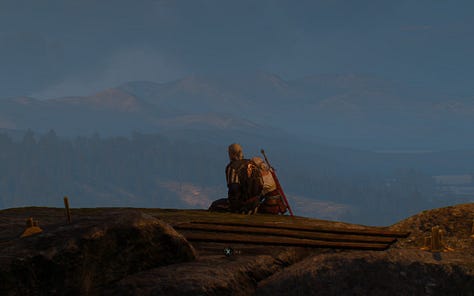


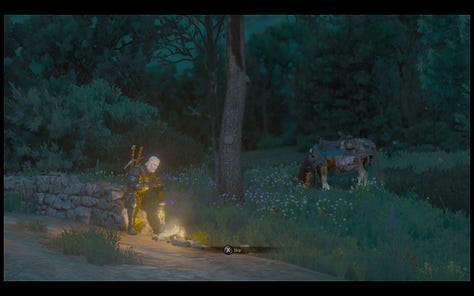

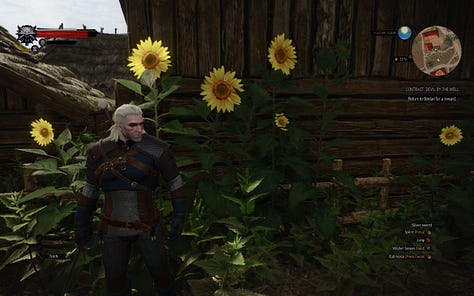

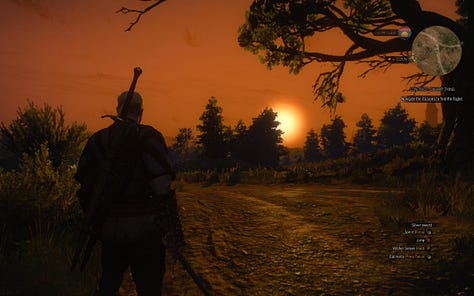
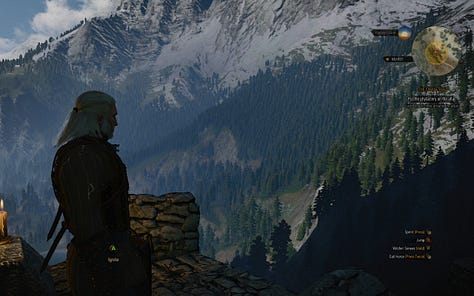
I experienced Geralt’s perspective as he traversed the land looking for Ciri. I became attached to him and other characters, feeling genuine empathy, anger, and all other emotions during the game’s main and side quests. When they did something stupid, too, I felt irritation. I mean, how many times can Yennefer micromanage Geralt and the situations they were in? However, I would choose Yennefer over Triss each time. Yennefer does a lot of bad things, but I couldn’t get over how Triss “fell in love with Geralt” when he had amnesia in games 1 and 2. I use that loosely. “Take advantage” is more like it. The pros of this game and its story are that you have the element of choice, right down to Geralt’s love interests.
Vesemir's death almost took me out. I remember that I was playing the Battle of Kaer Morhen downstairs in our basement. As I sat on the couch, Steam Deck in hand, I sobbed when Imlerith broke Vesemir’s neck. Before this game, I didn’t even know who he was, let alone care about him. This game has its way of stirring up emotions you didn’t know you had! When Ciri went on her revenge journey to avenge his death, I went on it, too. I was so angry.
My emotions also couldn’t handle it when Geralt finally found his adopted daughter Ciri on the Isle of Mists. He thinks she is already dead and that he is too late. You have been on this shared journey to find her, and the thought of losing her is too much. Geralt almost collapses, and then, he holds her lifeless body in his arms. And the flashbacks start. I mean… As a parent, my heart couldn’t handle it. I sobbed then, too, although I knew she would likely be OK. His emotional response, when he is supposed to be an emotionless Witcher, is nearly too much to bear. We know that his character is much more layered than the stereotypes placed upon him, from the Butcher of Blaviken moniker to being called a “freak” in nearly every single village.
I also chose correctly during Geralt’s time with Ciri and got her Witcher ending. I thought I messed up, though, because I thought she died at the end of this one. I played it over again. My emotions were all over the place then, too. I have since watched every ending and know I chose correctly with how I wanted the story to end.
Emotions aside (kind of), I loved the Scenes from a Marriage quest in the “Hearts of Stone” DLC, as I consider Iris to be an HSP. The painted world offered a nice break from the typical “Witcher 3” fare. The creepy elements and talking cats? A bonus.
I also loved the vampire and twisted fairy tale quests in the “Blood and Wine” DLC. I remember thinking Regis was shady and didn’t trust him at first. Then, I read the books and more about his original demise. I cried reading the books as well. I love the idea of Geralt retiring at Corvo Blanco, sipping some White Wolf wine, by the way. Dude deserves some solace after all of his monster slaying.
I have other games to play, but I have had trouble starting a new RPG. I went through a period of mourning after I finished “The Witcher 3” and a secondary one when I finished reading every book. I just got a new white-and-silver iPhone 16 Pro Max and named it U.S.S. Rivia. I’m on the hunt for the perfect memorabilia to put in our basement theater/pop culture room. No other game, besides my love of the “Zelda” franchise and “Skyrim,” has ever made me feel this way. I built confidence in my video-game skills and experienced an emotional response to a video game that I had never felt before. This story, and my continued work with narrative RPGs, provide the aforementioned catharsis. (And “The Witcher 4” looks gorgeous!)



No matter what we think about video games as a medium, they have the power to change your life for the better. They feel like home because they ARE home. They remind us of childhood, our darkest days, friendships, and more. These autobiographical memories arise each time we walk down the same virtual paths, redo a quest, obtain a goal, or hear familiar music. It’s a feeling we cannot describe other than the bittersweetness of nostalgia and going home again.
Now, on to “Mass Effect.” Another emotional experience, I am sure.
References:
Wholeheartedly Podcast EP30. Narrative Video Game Benefits for Highly Sensitive People
—------
Bojanowska, A. B., & Surowiec, A. (2022). Effects of brand experience: The case of The Witcher brand in the eyes of polish customers. Sustainability, 14, 1–13. https://doi.org/10.3390/su14010097
Koenitz, H. (2015). Narrative game mechanics – A concept and its application.
In Proceedings of the 10th International Conference on the Foundations of Digital Games.
Lankoski, P. (2016). Player character engagement in computer games. Game Studies, 16(1). http://gamestudies.org/1601/articles/lankoski
Mustafaev E. (2023). A philosophical analysis of moral choices in the Game The Witcher 3: Wild Hunt. Technology and Language, 5(1), 153-168. https://doi.org/10.48417/technolang.2024.01.11
Pluess, M., Aron, E., Kähkönen, J. E., Lionetti, F., Huang, Y., Tillmann, T., Greven, C., & Aron, A. (2025). Evolution of the concept of sensitivity and its measurement: The Highly Sensitive Person Scale-Revised. PsyArXiv. https://osf.io/preprints/psyarxiv/w7bqu.
Shackleford, K.E., Kohen, J.D., and Reed, P.A. (2025). You CAN go home again…and again: Psychological benefits of repeat media consumption. Manuscript submitted for publication. Perspectives on Psychological Science Compass. https://www.researchgate.net/publication/392731904_Shackleford_et_al_PSPCompass_2025_Submission_6-16-25
Tan, S.-L., Baxa, J., & Spackman, M. P. (2010). Effects of background music on the video gaming experience: Immersion and psychological responses to video game music. Psychomusicology: Music, Mind, and Brain, 22(1), 31–42. https://doi.org/10.1037/a0017881
Wirth, W., Hartmann, T., Böcking, S., Vorderer, P., Klimmt, C., Schramm, H., … & Jäncke, L. (2007). A process model of the formation of spatial presence. Media Psychology, 9(3), 493–525. https://doi.org/10.1080/15213260701283079
van Laer, Tom, Ko de Ruyter, Luca M. Visconti, and Martin Wetzels (2014). The Extended Transportation-Imagery Model: A meta-analysis of the antecedents and consequences of consumers' narrative transportation. Journal of Consumer Research, 40(5), 797-817. https://doi.org/10.1086/673383





